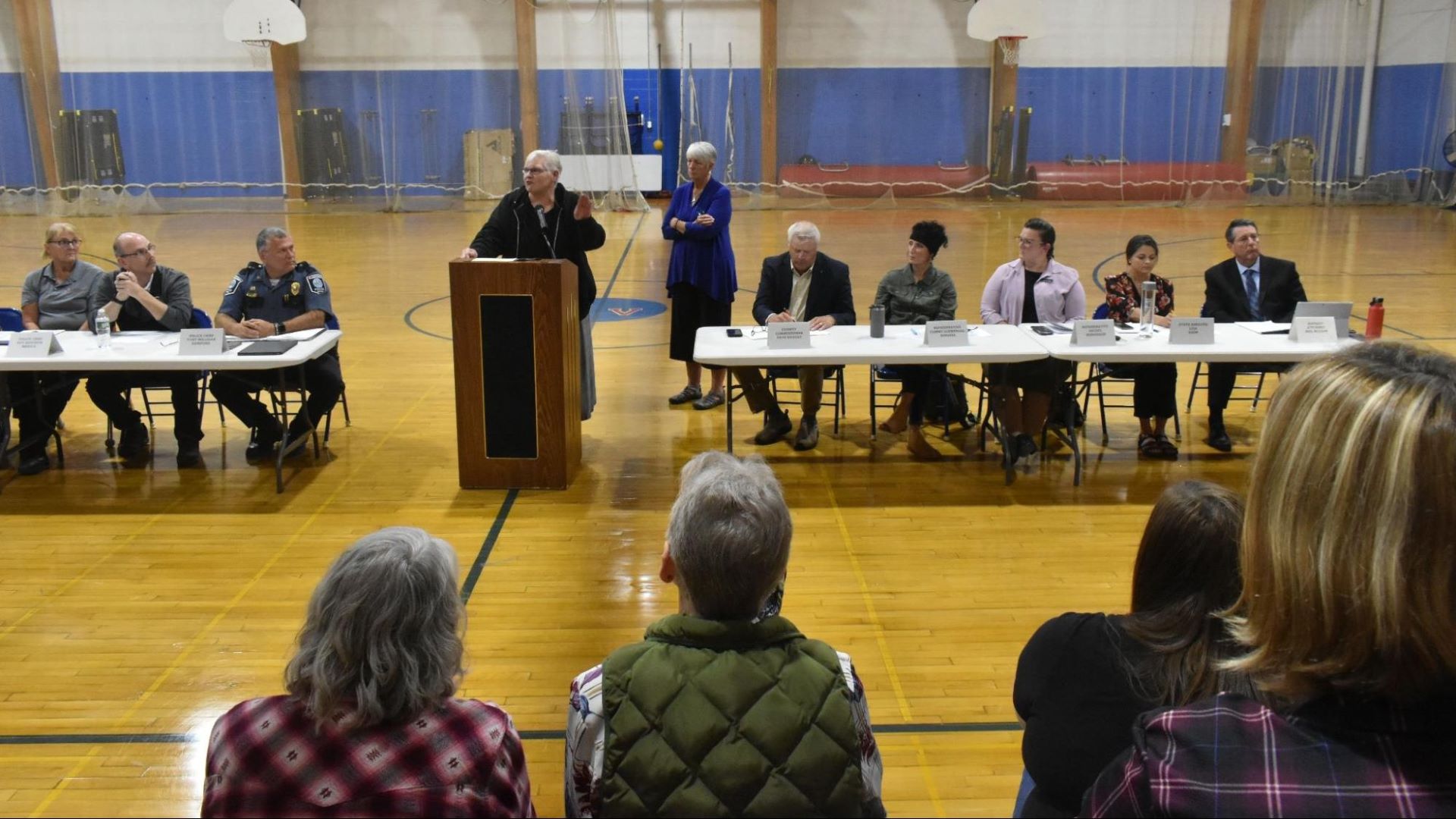Frustrations boiled over for River Valley residents at a town hall meeting in Mexico on Friday night as they shared harrowing details of how substance use, homelessness and crime in the community has affected their lives.
Some attendees shared their own personal stories of recovery from drug or alcohol use; while others described the deep pains of losing family members and loved ones from a fatal overdose.
Evidence of the opioid epidemic is hard to miss in their communities along the Androscoggin River, they said. Needles are strewn about their schools’ athletic fields, popular walking trails and in front lawns.
Gary Dolloff, a softball coach for Mountain Valley High School, said whereas once his players were able to arrive to games early to warm up or squeeze a few minutes of extra practice in, now they have to wait for him in case there are needles in the field, or people sleeping in the dugout who he’ll ask politely to leave.
“We need to help people get into recovery and take back the town,” Dolloff said in an interview after the meeting.
Among most speakers was a sense the River Valley had never seen the current scale of these problems before, and they demanded a path forward of cohesion, action and sincerity.
At the other end of their comments and poignant questions in the Mountain Valley Middle School gymnasium were their elected and municipal officials, who mirrored their concerns and tried to provide answers and solutions.
Most of the time, the only answers they had were: We are listening, we are frustrated, too, and we want to help. Elected officials also encouraged residents to testify on legislation they deem important and letting state legislators know the problems they’re facing.
The idea for the town hall came from Mexico selectman Kevin Jamison, who said he’s been listening to the growing concerns from River Valley residents about the trio of drug use, crime and homelessness in the communities along the Androscoggin River.
Jamison said that Mexico, with a population of about 2,700, is witnessing encampments of unhoused people where there never used to be any, and drug exchanges out in the open.
“This is the stuff you see in the big cities, and we’ve never seen anything like this in little Rumford and Mexico,” Jamison said in an interview.
When addressing these issues from the law enforcement and municipal government levels, Jamison said there has been some lapses in communication between community leaders.
The town hall served as an opportunity to put those leaders on the same page and resync their efforts, while also demonstrating need to the governor and state legislature about funding gaps in the River Valley.
“These little communities can’t handle the influx,” Jamison said, “We can’t deal with it money-wise, and we can’t handle it services-wise.”
Police departments stretched thin
Mexico Police Chief Roy Hodsdon said in an interview before Friday’s meeting there’s been an increase in both arrests and service calls in 2023 compared to recent years.
In 2022, the Mexico Police Department had a total of 149 arrests and summonses for all offenses, compared to 107 the year before. This year, the department had a total of 135 by the end of July.
The same goes for service calls, Hodsdon said.
His department has received 2,560 complaints this year, only a few hundred away from eclipsing the 2,942 it saw in the entirety of 2022.
“It’s just not stopping,” Hodsdon said. The sheer volume of calls is stretching his four-officer department, which has been an officer short since mid-summer. Hodsdon will often lend a hand in responding to those calls, including a report on Thursday of people occupying an abandoned building.
Hodsdon anticipates service call numbers to hit 3,800 by the year’s end, and that’s a conservative estimate, he said. Many of those calls are to report needles in public spaces, which the department will dispatch an officer to collect.
“It’s not uncommon to get a couple of calls each day or more to report needles,” Hodsdon said. “And we get it, you know. The public doesn’t feel comfortable picking them up. But, we’re inundated with those types of calls.”
Others come from people experiencing mental health crises or calls to abandoned buildings where people are living.
At Friday’s town hall, Rumford Police Chief Tony Milligan shared similar statistics. He said his department received 6,463 calls in 2022, a 54% increase from five years before. His officers are burnt out, Milligan said, reflecting the strains also faced by the Mexico Police Department.
One variety of service calls that is trending downward, however, are overdoses from opioid use, according to Hodsdon.
“I would say that a year ago, we were seeing a lot more overdose calls than we’re seeing now,” Hodsdon said. “And I attribute that to the great thing that everyone is carrying Narcan,” a brand of the overdose-reversing drug naloxone. “From citizens to law enforcement, you know, we’ve been carrying it since 2014.”
Promising trends in overdoses
According to Maine’s monthly overdose reports, Oxford County has experienced 10 fatal overdoses between this January and the start of August.
At the same time last year, the county had 18 fatal overdoses, increasing to 36 by the year’s end. Similarly, nonfatal overdoses are trending downward, too — there were a total of 205 up to the start of August this year, compared to 410 in all of 2022.
Berta Broomhall, deputy chief of the region’s EMS service Med-Care Ambulance, said at the town hall there are promising trends in the River Valley, more specifically.
For the 11 towns and 566 square miles that Med-Care covers, there were 16 overdoses in 2022, five of them fatal, Broomhall said. Thus far in 2023, there have been nine overdoses, and only one of them fatal.
Broomhall added that those who overdosed are also becoming more receptive to carrying naloxone or getting connected to recovery resources.
“There is a change there,” Broomhall said. “If we work together, we can make a difference.”
Kathie Williams, director of the Larry Labonte Recovery Center in Rumford, has been part of that push to get naloxone in the hands of River Valley residents.
Her organization distributes the life-saving drug from their location off of Waldo Street and trains anyone who’s interested in how to use it.
“We hand out more Narcan to the loved ones of people affected than people that are actually doing the drugs,” Williams said in an interview.
Williams said the heaps of judgment that was once cast on those with substance use disorder has waned, because many River Valley residents have been touched by opioid use directly, causing a change of heart.
“And the stigma is lessening because more people are being affected, more loved ones have been affected,” Williams said. “I don’t know if you can find anybody around here that hasn’t been affected one way or another.”
When discussing the context of Friday’s town hall in an earlier interview, Williams said she hoped the meeting would bring awareness to the dearth of resources in the River Valley and Oxford County at large when it comes to rehab centers and sober housing.
“Maybe these legislators will hear that and pass on that we need some help,” she said. “I mean we have next to nothing resources around here.”
Frustrations with the courts
Many attendees peppered law enforcement officials, including local District Attorney Neil McLean at the town hall, demanding answers as to why people they see arrested for offenses like burglary, drug trafficking or domestic violence are let back out on the streets a day later.
Mexico Police Chief Hodsdon recognized the concerns of some River Valley residents who are frustrated with how some of the department’s arrests are playing out in court.
“And then you know, you’re seeing in the papers … that these cases are being dismissed,” Hodsdon said in an interview. “And the victims become upset because” they’re asking: “‘What wasn’t done right, or: Why aren’t I important enough to handle this call?’”
“I know the court system is inundated with calls,” Hodsdon said. “I totally understand. [But] we have to figure out a way of holding people accountable, in my opinion.”
McLean answered the audience members’ questions Friday night by citing the overwhelming burdens confronting the state’s courts and his district, in particular.
He said District 3, which includes Oxford, Franklin and Androscoggin counties has the most pending cases statewide, with a total 4,800.
When addressing the sentences of convicted criminals, which attendees described as too light, McLean said he and his prosecutors do their best to speak on victims’ behalf and push for tougher penalties.
“The DA is not all powerful, we’re one of three voices” McLean said, explaining the roles of judges and defense attorneys.
“We know that the problem is getting worse and more cases are coming in, our prosecutors are working hard” to fight for you, McLean said. He encouraged crime victims to reach out to him directly to get a better understanding of the cases and arguments his office is pursuing.
The River Valley’s state legislators also attended Friday’s town hall, and Sen. Lisa Keim (R-Oxford) said they’re focusing on these issues at the state house in Augusta, and that the River Valley was not alone in the problems its facing.
She advocated for more funding for district attorney offices and jails, which she said are overcrowded, leading to the release of accused criminals.
“It’s a battle for dollars,” Keim said, and instead of focusing spending on harm reduction programs like clean needle exchanges, she said there should be more money put towards recovery and law enforcement.
Challenges to pursuing recovery
The lack of rehab centers means anyone looking to go into in-patient recovery has to travel out of the area to find it, abandoning their family and support system in Oxford County, Williams said.
Then, to stay on their recovery path, the county is similarly desolate in designated sober housing.
“If we had sober housing here, [then] people can live in a safe place, a good environment … and be able to remain part of the community,” Williams said.
Oxford County is slated to receive roughly $2.6 million over the next two decades from settlements with companies accused of contributing to the opioid epidemic statewide and locally, The Maine Monitor previously reported.
Williams has some ideas of where that money would be most effectively distributed, including expansions for the Larry Labonte Recovery Center and construction of sober housing, and has made that known to the Oxford County Commissioners.
Commissioner David Duguay, whose district includes Mexico and Rumford, said in an interview that the county is in the early stages of assembling a committee to determine where the settlement money will go.
In addition to the input of those committee members, Duguay said the town hall would be a good opportunity to hear from other county residents to hear what issues should be prioritized.
“We’re trying to do things that might be sustainable,” Duguay said, with the county choosing to accept the settlement money in increments, rather than all at once.
He said the county currently has around $240,000 on hand from recent payments, and will receive $50,000 annually over the next 17 years. Williams said there’s nothing more sustainable than solid housing.
“It’s a good place to give somebody a jump off, to be able to get them started,” Williams said. “Sober housing is sustainable. Because people do have to work in sober housing and they have to pay the rent. I think that would be a wonderful place to spend some money.”
Housing struggles
The River Valley faces additional shortages in its supply of emergency family housing, according to Michelle Worthley, director of homeless services for Rumford Group Homes.
She said the emergency shelter in Rumford has a typical waitlist of 20 to 70 people per day, and staffing shortages compound her organization’s ability to provide essential services.
Worthley, too, has noticed trends other River Valley residents brought to attention at the town hall meeting. She said her organization consistently has to turn people away who are actively using drugs, because they can’t allow people under the influence of drugs or alcohol into housing where children and families are present.
“And the problem that we are seeing more than ever before, is everybody that’s looking to come into shelter is under the influence and has absolutely no intention or will to get sober,” Worthley said.
She and her organization do their best to link those with substance use disorder to the appropriate people and resources, including Glenn Gordon, an outreach clinician for the Oxford County OPTIONS program who connects people to recovery services and treatment.
Worthley said there are some misconceptions about the efforts her organization puts into making these links. Community members might think that because there are people who are unhoused and currently using, it’s because Rumford Group Homes turned them away.
That’s not the whole story, Worthley said.
“We’re trying. Some people deny housing because they don’t want to get sober, or they’re not ready to get sober,” Worthley said. “So what do we do with that, as an agency?”
Samantha Cummings, a recovery coach at the Larry Labonte Recovery Center, advocated for those with substance use disorder at the town hall.
She encouraged community members not to stigmatize people in active addiction, and that you can’t force someone into recovery.
“People in addiction are not bad people,” Cummings said. “They’re just making bad decisions.”
Worthley identified the same funding priorities as Williams when it comes to treatment resources and housing.
“Right now there is no funding to my understanding for anybody that’s looking for substance use treatment,” Worthley said. “So maybe more funding to help out with that so that we can get some families back on track and wanting to get sober. And once they’re sober, once they’re willing to do the work, we’re right here.”







